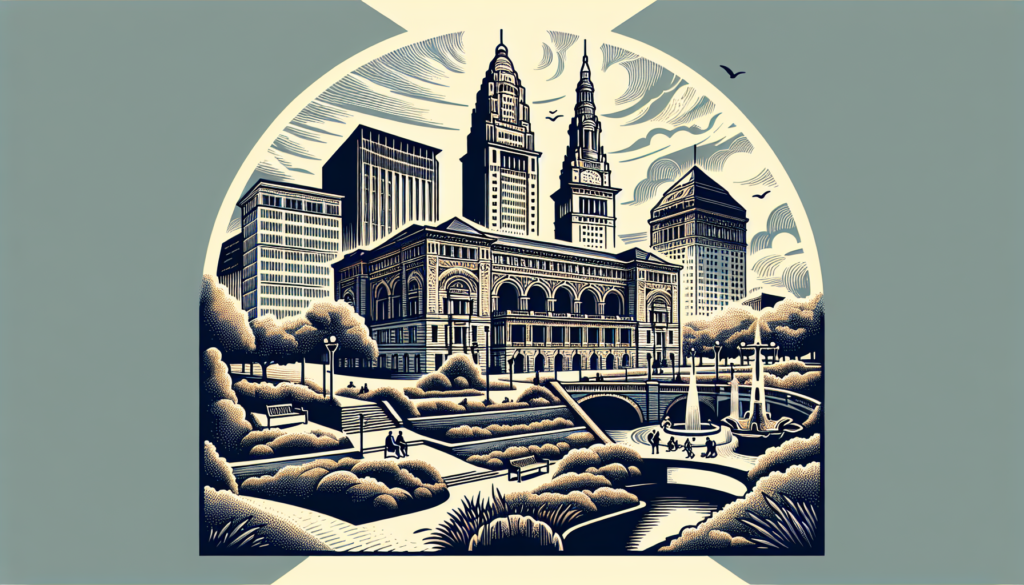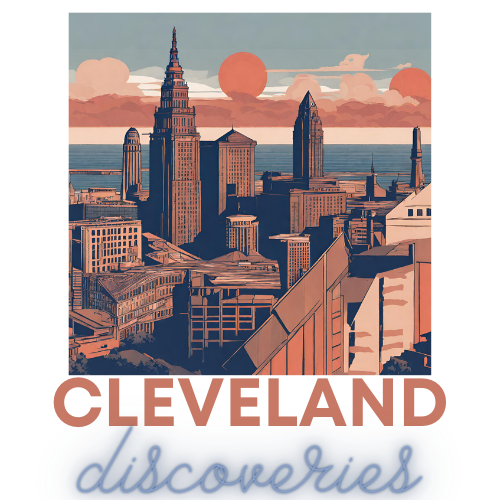Cleveland, a vibrant and historic city nestled on the shores of Lake Erie, boasts a rich tapestry of landmarks that have played pivotal roles in shaping its identity. From the iconic Rock and Roll Hall of Fame to the majestic Terminal Tower, these celebrated landmarks have captured the hearts of both locals and visitors alike. Join us as we embark on a journey through Cleveland’s storied past, exploring the most renowned landmarks that have stood the test of time and continue to leave an indelible mark on this captivating city.
The Terminal Tower
Construction and Design
The Terminal Tower, situated in downtown Cleveland, is one of the city’s most iconic and recognizable landmarks. Construction on this architectural masterpiece began in 1926 and was completed in 1930. Designed by Graham, Anderson, Probst & White, the Terminal Tower was conceived as the centerpiece of Cleveland Union Terminal. Standing at a towering height of 708 feet, it held the title of the tallest building in Cleveland until 1967. The Terminal Tower’s design incorporates elements of Beaux-Arts and Art Deco styles, featuring impressive detailing, elaborate ornamentation, and a grandeur that cannot be overlooked.
Iconic Status
The Terminal Tower has firmly established itself as an iconic symbol of the city of Cleveland. Its distinctive silhouette graces countless postcards, photographs, and promotional materials, making it instantly recognizable to both residents and visitors alike. With its towering presence and elegant design, it encapsulates the city’s rich history and enduring spirit. Locals identify the Terminal Tower as a symbol of Cleveland’s industrial past, while also serving as a beacon of progress and growth for the future.
Renovations and Current Use
Over the years, the Terminal Tower has undergone various renovations to ensure its continued relevance and functionality. Today, it serves as a multi-purpose building, housing a variety of businesses, offices, and even luxury residential apartments. The lower floors of the Tower feature an expansive shopping arcade, providing an enticing and convenient retail experience for locals and tourists alike. The Terminal Tower has admirably stood the test of time, skillfully blending its historical significance with modern purpose.
The Rock and Roll Hall of Fame
Inception and Design
The Rock and Roll Hall of Fame, an internationally renowned institution, was established in Cleveland in the late 1980s. Designed by renowned architect I.M. Pei, the building itself is a work of art. Its striking geometric form and iconic glass pyramid structure make it instantly recognizable. The design of the museum successfully represents the vibrancy and energy of rock and roll music, drawing visitors in with its unique aesthetic.
Collections and Exhibits
The Rock and Roll Hall of Fame is home to an extensive collection of artifacts, memorabilia, and exhibits that celebrate the history and impact of rock and roll music. From iconic stage costumes worn by legendary musicians to original handwritten lyrics and vintage instruments, the museum provides an immersive experience that brings the history of rock and roll to life. Interactive exhibits, multimedia presentations, and immersive installations further enhance the visitor’s understanding and enjoyment of this influential genre.
Impact on Tourism
Since its inauguration, the Rock and Roll Hall of Fame has had a profound impact on tourism in Cleveland. Drawing music enthusiasts from around the world, it has become a must-visit destination for fans of rock and roll and pop culture. The museum’s presence has sparked a resurgence of interest in the city’s vibrant music scene, with live music venues, local bands, and music festivals benefiting from increased exposure. This landmark has been a catalyst for economic growth, bolstering Cleveland’s cultural reputation and attracting visitors who contribute to the local economy.

This image is property of pixabay.com.
The Cleveland Museum of Art
Establishment and Architecture
The Cleveland Museum of Art, founded in 1913, is renowned for its exceptional collection and stunning architectural design. The main building was designed by prominent architects Benjamin Hubbell and W. Dominick Benes. Its neoclassical Beaux-Arts style showcases a grandeur that befits the esteemed artworks housed within. The museum has experienced significant expansions over the years, most notably with the addition of the Marcel Breuer-designed East Wing, which seamlessly blends modernist design principles with the classical aesthetic of the original building.
Collection Highlights
The Cleveland Museum of Art boasts an extensive collection spanning thousands of years and diverse cultures. From ancient Egyptian artifacts to European masterpieces and contemporary works, the museum’s collection offers something for every art enthusiast. Notable highlights include pieces by renowned artists such as Van Gogh, Monet, and Caravaggio. The museum also houses an impressive collection of Asian art, featuring exquisite Chinese porcelain, Japanese prints, and Korean ceramics. The diverse range of artworks ensures there is always something new and exciting to discover at the Cleveland Museum of Art.
Community Engagement
Beyond its collection, the Cleveland Museum of Art plays an active role in engaging and enriching the community. It offers a wide range of educational programs, including lectures, workshops, and guided tours, aimed at fostering an appreciation for art among people of all ages. The museum also collaborates with local schools, providing resources and outreach programs to students, ensuring that art education remains accessible and inclusive. Through its community engagement efforts, the Cleveland Museum of Art continues to inspire and educate, making art a vibrant and integral part of Cleveland’s cultural landscape.
FirstEnergy Stadium
Origins and Construction
FirstEnergy Stadium, situated on the shores of Lake Erie, is the venerable home of the Cleveland Browns football team. Originally known as Cleveland Municipal Stadium, it was constructed in 1931 as a Works Progress Administration project during the Great Depression. The stadium underwent major renovations in the 1990s to accommodate modern requirements, and in 2013, it was renamed FirstEnergy Stadium as part of a sponsorship agreement.
Home of the Cleveland Browns
FirstEnergy Stadium has played a significant role in the history of the Cleveland Browns. As the home stadium for the team, it has witnessed countless thrilling games, unforgettable moments, and passionate fans. The stadium’s electric atmosphere and capacity to accommodate over 67,000 spectators foster an unparalleled sense of camaraderie among fans, making attending a Browns game an unforgettable experience.
Renovations and Future Plans
Continuously striving to enhance the fan experience, FirstEnergy Stadium has undergone several recent renovations. From upgraded seating and improved sightlines to state-of-the-art video boards and enhanced concession areas, these updates ensure that fans can enjoy the game in optimal comfort and convenience. Furthermore, there are plans for future renovations, including the addition of new amenities and technology, further solidifying FirstEnergy Stadium as a premier sports venue in Cleveland.
Progressive Field
Creation and Features
Progressive Field, formerly known as Jacobs Field, is the esteemed home of the Cleveland Indians baseball team. It was officially opened in 1994 and quickly became a beloved landmark in the city. The stadium’s design beautifully blends modern amenities with classic architectural elements, creating a welcoming and comfortable experience for fans. With features such as the Heritage Park, paying homage to the team’s history, and the iconic “Guardians of Traffic” statues, Progressive Field is a testament to the pride Clevelanders have for their baseball team.
Home of the Cleveland Guardians
Progressive Field has been the site of numerous memorable baseball moments and has encapsulated the aspirations and passions of the Cleveland Guardians and their devoted fans. The stadium’s electric energy and passionate supporters have created a formidable home-field advantage for the team, igniting an atmosphere of excitement and unity that can be felt throughout the stadium. Attending a game at Progressive Field is a cherished tradition for many Clevelanders, fostering a deep connection between the team, the city, and its residents.
Events and Attendance
Beyond baseball games, Progressive Field has also become a vibrant venue for various events and gatherings. Concerts, community events, and corporate functions are frequently held within its premises, further solidifying its status as a multi-purpose facility. The stadium’s prime location, coupled with its versatile capabilities, attracts visitors from near and far, injecting vitality into the surrounding area and contributing to the city’s cultural landscape.
The Arcade
Historic Significance
The Arcade, a historically significant landmark in downtown Cleveland, has been a center of commerce and social activity since its completion in 1890. It is one of the earliest indoor shopping centers in the United States and represents a blending of innovative architecture and functional design that was ahead of its time. Its distinctive glass roof and beautifully ornate facades have made it a cherished part of Cleveland’s history and architectural heritage.
Architecture and Interior Design
The Arcade’s architectural design is a captivating blend of Victorian Gothic and Romanesque Revival styles. The grandeur of its exterior is matched only by the intricate beauty of its interior. A stunning five-story atrium, bathed in natural light, serves as the centerpiece, with elegant balconies and cast-iron railings adorning the upper levels. The Arcade’s unique blend of architectural styles and meticulous interior design truly transports visitors to a bygone era, evoking a sense of nostalgia and appreciation for its enduring beauty.
Adaptive Reuse and Revitalization
In recent years, the Arcade has been revitalized through adaptive reuse efforts, transforming it into a modern mixed-use development. The upper levels of the building now house luxurious apartments, providing residents with a unique and luxurious living experience. The lower levels retain elements of its original function as a hub for commercial activity, hosting an array of upscale boutiques, restaurants, and specialty shops. The successful revitalization of the Arcade showcases the city’s commitment to preserving its historical treasures while adapting them for modern use.

This image is property of pixabay.com.
Cleveland Public Library
Founding and Growth
The Cleveland Public Library, founded in 1869, has grown to become one of the largest and most esteemed public library systems in the United States. Its establishment was driven by a commitment to provide free and accessible education to all, regardless of their socioeconomic status. Over the years, the library system has expanded its reach, opening multiple branches throughout Cleveland and continually evolving to meet the needs of its diverse community.
Distinctive Architecture
The main branch of the Cleveland Public Library, located in downtown Cleveland, is a magnificent architectural gem. Designed by the renowned firm Walker and Weeks, the building’s neoclassical design incorporates elements of the Italian Renaissance. Its grand exterior features Corinthian columns, ornate sculpture work, and a majestic dome, reflecting the library’s stature as a cultural and intellectual hub. The distinctive architecture and attention to detail make visiting the Cleveland Public Library an awe-inspiring experience.
Special Collections and Programs
The Cleveland Public Library is renowned for its extensive collection of books, periodicals, and digital resources, serving as a vital resource for the community. In addition to its vast general collection, the library also houses several special collections, including the John G. White Collection of Folklore and Orientalia and the Frederick C. Hicks Collection of Lincolniana. These unique collections ensure that the library remains a destination for scholars, researchers, and enthusiasts seeking specialized knowledge and rare materials. The library also offers a wide range of programs, from author readings to workshops and educational events, fostering a love of reading and lifelong learning within the community.
Museum of Contemporary Art Cleveland
Evolution and Architecture
The Museum of Contemporary Art Cleveland (MOCA) has emerged as a significant cultural institution dedicated to contemporary art in the city. The museum was initially founded in 1968 and moved to its current location in 2012. The building, designed by renowned architect Farshid Moussavi, stands as a work of art in itself. Its dynamic and angular design, featuring a striking facade clad in black stainless steel, boldly reflects the contemporary artworks housed within. MOCA’s architecture provides a stimulating backdrop for the diverse range of contemporary artistic expressions on display.
Exhibitions and Programs
MOCA is committed to showcasing groundbreaking contemporary art and providing a platform for emerging and established artists. The museum’s dynamic exhibition program features thought-provoking installations, immersive multimedia experiences, and boundary-pushing exhibitions that challenge traditional notions of art. MOCA’s programs extend beyond the gallery walls, including artist talks, workshops, and community engagement initiatives that aim to foster dialogue and understanding of contemporary art among visitors of all backgrounds.
Contemporary Art Impact
MOCA’s presence in Cleveland has had a significant impact on the local art scene and the broader community. By providing a platform for contemporary artists to exhibit their work, MOCA has actively contributed to the cultural vibrancy of the city. It has also sparked important conversations and dialogue around contemporary art, challenging visitors to engage with diverse perspectives and ideas. MOCA’s commitment to accessibility and inclusivity ensures that contemporary art remains an accessible and engaging experience for all.

The Cleveland Metroparks
Creation and Expansion
The Cleveland Metroparks, often referred to as the “Emerald Necklace,” represent a vital and cherished part of the city’s landscape. The creation of the Metroparks can be traced back to the 1917 acquisition of land along the Rocky River. Today, the park system spans over 23,000 acres, encompassing a variety of natural habitats, including forests, rivers, and lakefront areas. The Metroparks continue to expand, with ongoing efforts to acquire and preserve additional green spaces for future generations to enjoy.
Preservation of Green Spaces
One of the primary goals of the Cleveland Metroparks is the preservation and conservation of natural habitats and green spaces within the city. The park system provides a sanctuary for native flora and fauna, ensuring that essential ecosystems remain intact. The Metroparks actively engage in ecological restoration projects, reforestation efforts, and the protection of endangered species, contributing to the overall health and biodiversity of the region. These green spaces offer respite from the urban environment, providing opportunities for outdoor recreation, relaxation, and exploration.
Recreational Opportunities
The Cleveland Metroparks offer a wealth of recreational opportunities for visitors of all ages and interests. From hiking and biking trails to fishing and boating, the park system provides a diverse range of activities to suit every outdoor enthusiast. Golf courses, picnic areas, and nature centers further enhance the visitor experience, fostering a sense of connection with nature and a deep appreciation for the beauty of the Cleveland landscape. The abundant recreational opportunities available within the Cleveland Metroparks make it a treasured resource for residents and a draw for visitors seeking outdoor adventure and natural beauty.
The West Side Market
Historic Origins
The West Side Market holds a cherished place in Cleveland’s history, standing as one of the oldest continuously operating public markets in the United States. Opening its doors in 1912, the market has been a hub for commerce, social interaction, and culinary delights for over a century. Its founding was driven by a desire to provide the growing immigrant population with fresh, high-quality food and a place to connect with their cultural roots. Today, the West Side Market showcases the city’s diverse culinary scene and is deeply rooted in the city’s cultural fabric.
Architecture and Features
The West Side Market’s architecture is a testament to the enduring beauty of historic marketplaces. The building, designed by Hubbell and Benes, features a stunning exterior adorned with intricate stone carvings. Inside, the market’s high vaulted ceiling and arched windows create a charming and inviting atmosphere. The market is divided into different sections, each dedicated to a specific type of food, including fresh produce, meats, seafood, bakery items, and specialty foods. This unique layout ensures that visitors can easily navigate the market and explore a wide variety of culinary delights.
Cultural and Culinary Destination
The West Side Market has become a beloved cultural and culinary destination, attracting food enthusiasts from near and far. It serves as a thriving hub for local farmers, artisans, and small businesses, offering a platform for them to showcase their products and connect with the community. Visitors to the market can indulge in an array of delectable treats, including ethnic delicacies, local farm-fresh produce, and homemade pastries. The West Side Market embodies Cleveland’s culinary heritage and serves as a gathering place where people can come together to celebrate and appreciate the city’s diverse food culture.
In conclusion, Cleveland’s history is richly woven with landmarks that have shaped the city’s cultural and architectural identity. From the grandeur of the Terminal Tower to the vibrant energy of the Rock and Roll Hall of Fame, these landmarks are testaments to Cleveland’s storied past and its commitment to preserving its heritage while embracing progress. Whether exploring the diverse collection of the Cleveland Museum of Art, cheering on the beloved Browns at FirstEnergy Stadium, or strolling through the natural beauty of the Cleveland Metroparks, there is no shortage of iconic landmarks to discover and enjoy in this friendly and vibrant city. With its unique blend of history, art, sports, and natural beauty, Cleveland continues to captivate residents and visitors alike with its array of world-class landmarks.


